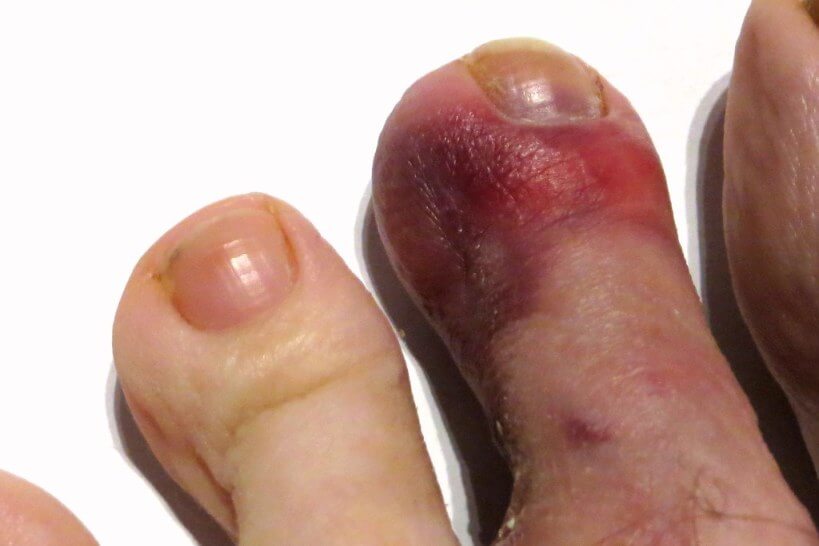Purple Toe: Causes And Treatment
In many occasions, our feet can be injured by practicing a sport such as running or if a heavy object falls on the toes. These injuries usually generate changes in the shape and coloration of the finger.
In addition to an injury, there are many causes that can cause purple toe, such as the use of inappropriate footwear. When discovering that a toe is purple or has a similar alteration, it is advisable to consult with your doctor immediately.
To prevent any of these discomforts from generating the presence of a purple toe, we invite you to read this article where you will learn much more about the purple toes: causes and treatment.
Table of Contents
Causes of purple toe
The causes that can give rise to the appearance of a purple toe are multiple, including:
Acute injuries
In this group are those that are generated after direct trauma, either through a fall, sprain or penetrating puncture injury.
Puncture wounds
Injuries caused by objects (such as nails, knife, tacks or needles) carry the risk of developing an infection; this is due to the difficulty of the area to be treated. When the foot is inside the footwear, the proliferation of bacteria increases, due to the moisture that exists between the toes and the foot.
Specifically, there is a bacterium called pseudomonas, which appears frequently in those injuries caused by a puncture wound produced through the sole of a sports shoe.
Bruises
The purple or blue toe may appear after an ankle injury as the coloration spreads to the toes due to gravity.
Tendon injuries
This type of injury is generated when an Achilles tendon tear occurs.
It is frequent in children and adolescents who suffer from an alteration known as Sever’s disease, which consists of an injury to the growth bone where the aforementioned Achilles tendon is connected.
Sprains
They are ligament injuries, which are responsible for connecting one bone to another. Symptoms of this condition can be mild or severe. Sometimes they can be mistaken for a fracture.
When this happens, swelling and purple discoloration of the foot, as well as the toes, is evident, depending on where the injury occurred.
Toe fractures
It can happen when the toes are hit by a heavy object or when it falls on it. This brings about the appearance of purple spots on the injured fingers or on the entire foot.
Plantar fasciitis
It is an inflammatory process of the plantar fascia, a wide and flat ligament that is located in the lower part of the foot: it runs from the front of the heel to the base of the toes. Its function is to help maintain the arch of the foot. An injury at this level can generate pain and inflammation, in addition to the color change in the toes.
Diabetes purple toe
Diabetes mellitus (DM) is a chronic disease that, in the long run, affects the nerves, generating an alteration known as diabetic neuropathy, which generally causes:
- Pain
- Tingling sensation
- Loss of sensation in the feet.
Keep in mind that it can be aggravated with the appearance of a blister or a stone in the shoe, since not feeling them, can cause discoloration changes in the toes, where the purple toe can be even darker.
Also, this disease generates circulatory disorders that consist of decreased blood flow to the feet. If there is an infectious process in any of them, it is much more difficult for the injury to heal. Therefore, in some cases it can aggravate and end in gangrene.
Gangrene
Gangrene is the death of cell tissue due to lack of blood supply or a serious bacterial infection. This alteration affects the limbs, fingers or toes.
In these cases, purple coloration is seen, even much darker as a result of the death of cell tissue.
Purple Toe Treatment
The treatment of injuries to the toes, especially the purple coloration of the toes, should be indicated by the specialist doctor, in this case the traumatologist.
When you are in the presence of a disease such as diabetes mellitus, it is important to have the presence of a multidisciplinary team where the neurologist and internist are in addition to the traumatologist.
According to the symptoms present, the treatment to be followed will be indicated, this goes from:
- Repose
- Physiotherapy
- Pain relievers or anti-inflammatory: To relieve pain and inflammation present in the affected area of the toes.
- Antibiotics: It should be used when the purple coloration of the toes is the product of an infectious process.
- Surgery: This will depend on the functional limitation that the injury generates, as well as the severity of it, with this it will avoid placing the patient life at risk.
Prevent the appearance of the purple toe
The feet and especially the toes require certain care to prevent the appearance of injuries or changes in color. Any injury can limit the ambulation of people, for this reason, it is important to take the following precautions:
Recommendation
- Check your feet regularly to see if there are any wounds or discoloration.
- Avoid walking barefoot on hot or wet surfaces such as in sports centers or locker rooms.
- Change socks daily, with major reason if they are wet.
- Wear comfortable shoes, it is not recommended to wear very high shoes in the case of women.
Foot cleaning
- Wash your feet gently daily with soap and warm water.
- Then dry them very well, especially between each finger.
- Use moisturizer to keep the skin moist, do not apply cream between the fingers.
- Keep your nails short in a straight line.
Finally, if you have an injury and your toes are purple, do not hesitate to consult with your trusted doctor, who after a medical review will determine the type of injury that you have. Likewise, once the cause is determined, the treatment you require will be initiated according to the discomfort that you present.

